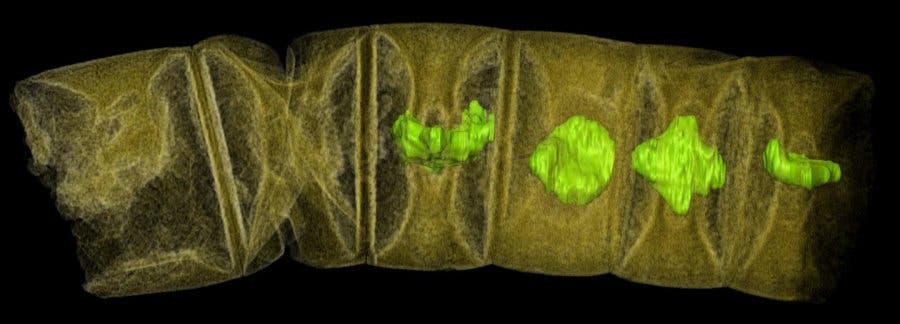Scientists have uncovered 1.6 billion-year-old fossils from multicellular organisms, likely red algae. The findings indicate that multicellular life evolved much faster than we thought.

The scientists found the incredibly well-preserved fossils in sedimentary rocks called phosphorites at Chitrakoot in central India, embedded in fossil mats of cyanobacteria, called stromatolites. Although it’s hard to say for sure what they are, they’re definitely multicellular and they seem to resemble the structure of modern red algae.
“Back in the days when they were living and growing this would have been a shallow marine system with plenty of sunlight,” says study co-author and geobiologist Therese Sallstedt.
Red algae are one of the oldest groups of eukaryotic algae, consisting of mostly multicellular, marine algae, including many notable seaweeds. Researchers found two types of presumed algae: one type is thread-like, while the other consists of fleshy colonies. The team looked at them with help of synchrotron-based X-ray tomographic microscopy finding, among others, regularly recurring platelets which they believe are chloroplasts — the specialized organelles in which photosynthesis takes place.
“You cannot be a hundred per cent sure about material this ancient, as there is no DNA remaining, but the characters agree quite well with the morphology and structure of red algae,” says Stefan Bengtson, Professor emeritus of palaeozoology at the Swedish Museum of Natural History.
The earliest life form ever discovered dates from 3.5 billion years ago (though a more recent estimate suggests 3.7 billion years ago). These were simple, single-celled organisms, lacking a nucleus and other organelles. For the longest time, all life on Earth remained microscopic, up until 600 million years ago, when the first “visible life” emerged — multicellular organisms emerged a bit earlier, 1.2 billion years old. Or so we thought.
“The ‘time of visible life’ seems to have begun much earlier than we thought,” says Stefan Bengtson.
If these findings stand, it might force us to recalibrate the early days of the tree of life, because these predate the oldest algae by 400 million years. The problem with that timeframe is that fossils are extremely scarce,
“[Cyanobacteria] changed forever the state of the atmosphere, releasing oxygen that we breathe,” Sallstedt says. “As did plants, in a way. They didn’t invent photosynthesis, but they took it to the next level.”
Journal Reference: Stefan Bengtson, Therese Sallstedt, Veneta Belivanova, Martin Whitehouse. Three-dimensional preservation of cellular and subcellular structures suggests 1.6 billion-year-old crown-group red algae. PLOS Biology, 2017; 15 (3): e2000735 DOI: 10.1371/journal.pbio.2000735
Was this helpful?



